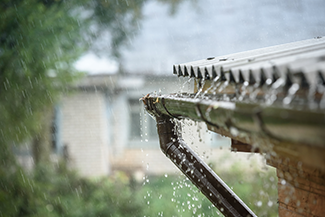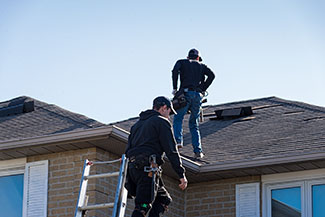Is Your Roof Ready for the Monsoon?
Getting Your Roof Ready for Monsoons
Homeowners that are new to Arizona, may be surprised to know that we have enough rain to cause concern for leaky roofs. Arizona roofs work hard all year, especially during the monsoon season. Brandon Niskanen, owner of Rosie on the House Certified Pinnacle Roofing tells us, "the dynamic temperature of Arizona is a big challenge for residential homes. Monsoons can wreak havoc on a roof that has been neglected under the Arizona sun." Monsoon season runs June through September and can dump large amounts of rain in a short time as well as deliver high winds, hailstorms and lightening.
Can I inspect My Roof Myself?
We don't generally suggest that people climb around on their roof tops. It is way too easy to fall from a steep or slippery roof and the probability of causing damage by walking on tiles or shingles is high.
How often a roof should be professionally checked depends on the age of the roof. Brandon emphasizes the importance of having your roof inspected by a professional roofer on a regular basis but especially after a significant storm.
- Tile & Asphalt Roofs | Under normal circumstances a quality tile or asphalt roof should be maintenance free for a good 8-10 years. If there has been a significant storm or construction that involves the roof it would be a good idea to check more often. For instance, in 2010 Maricopa County was hit with a major hailstorm that damaged 150,000 homes. If you are one of the homeowners who had a roof replaced by that storm it is time to start yearly checkups of your roof.
- Flat Roofs | Flat roofs, characterized by the white elastomeric coating, require higher maintenance and should be checked every year starting from about 3-5 years of age. Typically, the elastomeric covering on the foam needs to be redone every 5 to 7 years.
Things to Watch For:

You can prevent a small problem from turning into a big one just by being observant. Every 6 months or after a storm, take a walk about. From the ground, walk the perimeter of the house. Signs that your roof needs immediate attention are:
- Broken concrete or clay tiles.
- Missing or loose asphalt shingles.
- Metal flashing around vents or chimneys that have come loose.
- Check the texture of a flat roof. If you are comfortable on a ladder, you can look to see if the coating is still "smooth" and similar to the texture of a basketball. If it appears more like popcorn, then the surface is deteriorating.
Preventative Measures Homeowners Should Take:
There are maintenance tasks involved in the care of your roof. Whether you execute these tasks yourself or hire a professional, these preventative measures will be helpful in avoiding leaks due to minor damage or a backup of water due to debris.
- Remove any accumulated tree and plant debris from the roof. Be especially particular to keep screens on drain scuppers and gutters clear as well.
- Trim tree branches hanging over the roof to limit the amount of falling debris caught by your roof and to ensure the branches are not hitting your roof, especially during high winds.
- Inspect transitions where your flat roof joins a tiled or shingled roof to see if there are holes that could let water into the house.
- Reattach loose roofing material or drip-cap flashing on outer edges of the roof.
- Fill holes pecked by birds in foam roofing.

Gutters:
Rosie highly recommends having gutters installed if you don't have them already. A gutters' job is to redirect rainwater at least 12 inches from the house in order to protect the homes foundation. This is particularly effective in a monsoon storm or microburst where the water comes down in buckets and pools around the house.
Oh No, I sprung a leak!
If you missed a problem and your roof begins to leak during a storm, chances are you will have visible water damage from the inside of your home. If the water is coming through a fixture or ceiling fan, just set a 5-gallon bucket under the leak and wait it out. Turn off the breaker to that fixture and leave it off until the leak is fixed.
If, however, the water is bulging from mid ceiling somewhere, be proactive. Have a 5-gallon bucket ready to catch the water and puncture a small hole with something like a screwdriver through the paint and/or drywall to release the water. Letting the water out will save you time and money when it comes to the in mess in and the clean-up. A pin hole in the paint and drywall is much easier to repair than replacing the insulation and sheetrock that could fall from the ceiling.
Home Maintenance To Do: #MonsoonPrep | Be prepared for summer storms
Sponsored by Pinnacle Roofing
 With more than 25 years of roofing experience, Pinnacle Roofing provides roofing inspections, repairs and replacement services for customers valley-wide and offers comprehensive warranties for most all types of roofing from repairs to re-roofs, residential and commercial. Specialties include foam roofing, tile roofing and roof coatings. Contact Pinnacle Roofing to schedule your winter maintenance.
With more than 25 years of roofing experience, Pinnacle Roofing provides roofing inspections, repairs and replacement services for customers valley-wide and offers comprehensive warranties for most all types of roofing from repairs to re-roofs, residential and commercial. Specialties include foam roofing, tile roofing and roof coatings. Contact Pinnacle Roofing to schedule your winter maintenance.
###
